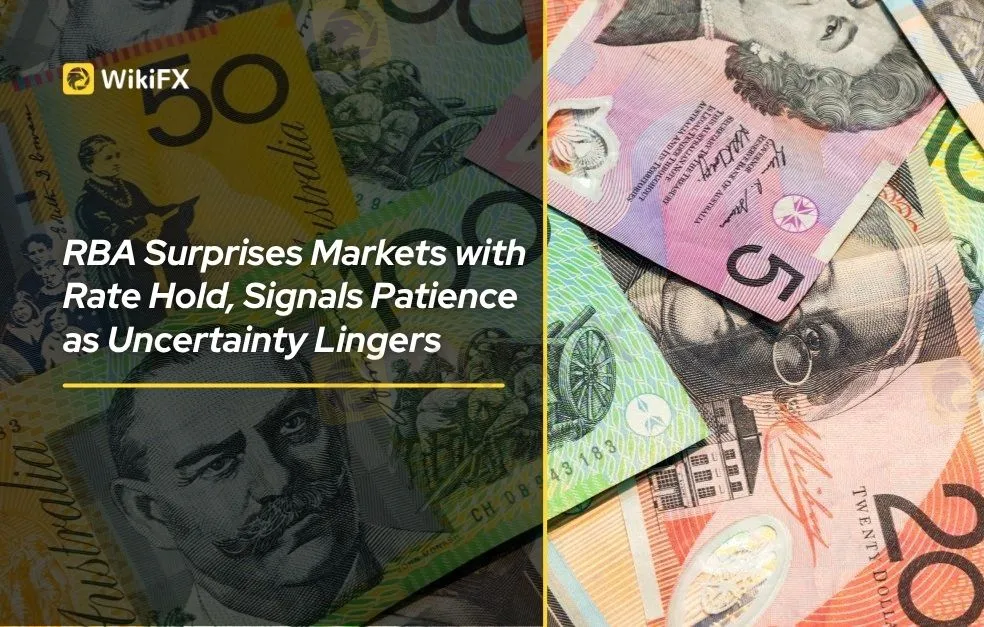简体中文
繁體中文
English
Pусский
日本語
ภาษาไทย
Tiếng Việt
Bahasa Indonesia
Español
हिन्दी
Filippiiniläinen
Français
Deutsch
Português
Türkçe
한국어
العربية
RBA Surprises Markets with Rate Hold, Signals Patience as Uncertainty Lingers
Abstract:The RBA held interest rates at 3.85% in July, surprising markets that had priced in a cut. Policymakers cited inflation risks and global uncertainty as reasons to stay cautious.

In a move that caught many by surprise, the Reserve Bank of Australia (RBA) opted to leave its benchmark interest rate unchanged at 3.85% in July, resisting market speculation of a rate cut despite easing inflation indicators and a sluggish economy.
The decision came amid divided views on the economic outlook, highlighting the central banks cautious approach as it weighs local disinflation against an unpredictable global environment. While some analysts had anticipated a policy shift, the RBA made clear it is not ready to pivot just yet.
A Divided Path Forward
The rate pause follows growing debate among economists about how to support Australias slowing growth without undermining progress on inflation. Recent consumer data—including weak household spending and modest wage growth—suggest that the economy is losing momentum. However, with inflation easing only gradually and labor markets still showing resilience, the RBA is holding firm.
Instead of rushing to ease, the central bank emphasized the need for “additional clarity” before altering its current stance. A statement accompanying the decision pointed to ongoing risks from abroad, including rising geopolitical tensions and volatile commodity prices, as key reasons to remain patient.
Markets React, Expectations Reset
Financial markets quickly responded to the unexpected outcome. The Australian dollar strengthened against major currencies, while yields on short-term government bonds rose as traders adjusted expectations for future cuts. Some analysts now believe any policy shift may be delayed until late Q3, depending on how inflation and employment trends evolve.
Economists say the board‘s message is less about tightening and more about buying time. “The RBA isn’t ruling out further easing, but its waiting for stronger confirmation that inflation is firmly under control,” noted one Sydney-based strategist.
Pressure Builds on Policymakers
The central banks wait-and-see approach puts additional pressure on fiscal policymakers to do more. Calls for targeted stimulus and cost-of-living relief have grown louder in recent weeks, particularly as households continue to feel the squeeze from elevated borrowing costs.
At the same time, observers warn that a prolonged pause could risk further economic slowdown, particularly if global trade tensions intensify or consumer confidence weakens further.
Still, the RBA appears to be signaling that stability is the priority—for now. “We remain ready to respond if conditions shift sharply,” the boards statement concluded, underscoring a data-driven stance rather than a pre-set trajectory.
With its next meeting scheduled for August, the central bank is expected to reassess its position based on updated quarterly inflation data and broader economic signals. For now, Australias monetary policy remains in holding mode—anchored by caution, and shaped by a world still full of unknowns.
Disclaimer:
The views in this article only represent the author's personal views, and do not constitute investment advice on this platform. This platform does not guarantee the accuracy, completeness and timeliness of the information in the article, and will not be liable for any loss caused by the use of or reliance on the information in the article.
WikiFX Broker
Latest News
Alchemy Markets Review 2025: Key Facts and Insights
Largest Market Makers
Temasek's portfolio scales new peak even as divestments hit over 2-decade high
Exposing Trade Capital Limited - Siphoning Millions, Restricting Withdrawals, Charging Extra Fees
GMI Edge: A Closer Look at Its Licenses
How Do I Place a Stop-loss Order?
5 Serious Warnings About Mirrox! You Can’t Afford to Ignore
FXPRIMUS: 5 Things They Don’t Want You to Know
Manual vs. Automated Forex Trading: Which One Should You Choose?
Mining firms lift FTSE 100 to record high after Trump confirms 50% copper tariff
Currency Calculator


